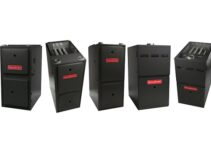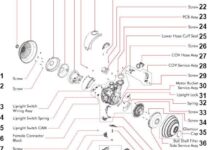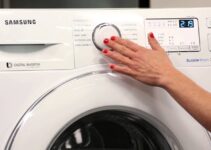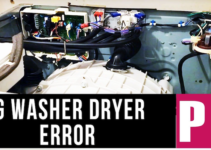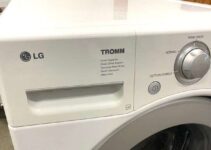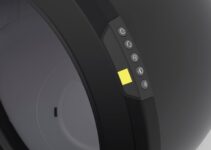If your Hotpoint fridge is not cooling, you might need to check your temperature settings. However, if everything seems to be in perfect order and the fridge fails to cool still, then it might have a defective component.
The guide below should help you find the problem and fix it.
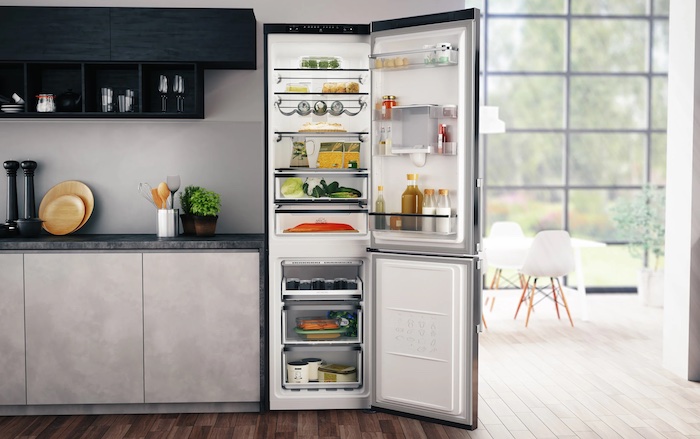
Hotpoint Fridge Not Cooling: Likely Causes & DIY Fixes
1. Faulty Condenser Fan Motor
This is the most common cause of a Hotpoint fridge failure. The condenser fan motor is designed to draw air though the condenser coils and over the compressor. A faulty condenser fan motor would cause the refrigerator not to cool properly.
How to Fix
To check if the fan motor is defective, check the fan blade for obstructions.
- Locate the fan motor and fan blade. They should be near your condenser coils.
- Inspect the fan blades and check that they are free of obstructions and clean. If they’re dirty, you need to use a damp soft cloth to clean them off and remove any debris.
- Next, you need to try turning the fan motor blade by hand. If the blade spins freely, then the condenser fan is working perfectly. If it does not spin freely, then the condenser fan motor would have to be replaced.
- If the fan blade spins freely and there is no obstruction, you will have to use a multimeter to test the fan motor for continuity. If the condenser fan motor does not have continuity, then it would have to be replaced.
2. Faulty Evaporator Fan Motor
The evaporator fan motor works in a similar way to the condenser fan, only slightly differently. The function is to draw air over the evaporator coils and circulate it throughout the refrigerator and freezer compartments.
Depending on your refrigerator model, it might be only one evaporator, which should be located in the freezer compartment. If the evaporator fan fails or is faulty, then it will not be able to circulate the cold air to the refrigerator compartment. In this case, the freezer may still get cold, but the refrigerator will not get cold.
How to Fix
You need to check if the evaporator fan motor is defective. To do this;
- Locate the fan motor and fan blade. They should be near your evaporator coils.
- Inspect the fan blades and check that they are free of obstructions and clean. If they’re dirty, you need to use a damp soft cloth to clean them off and remove any debris
- Next, you need to try turning the fan motor blade by hand. If the blade spins freely, then the evaporator fan is working perfectly. If it does not spin freely, then the evaporator fan motor would have to be replaced.
- If the motor does not run at all, you will have to use a multimeter to test the motor windings for continuity. If the windings do not have continuity, then they would have to be replaced.
3. Defective Start Relay
The start relay is designed to work with the start winding to start the compressor. With a defective start relay would the compressor may sometimes fail to run or may not run at all. When this happens, the refrigerator will not be cold enough.
How to Fix
To check if the start relay is defective, you will have to use a multimeter to test it for continuity between the run and start terminal sockets.
If you test it and the start relay does not have continuity between the run and start terminal sockets, then it would have to be replaced. In addition, You need to also check if the start relay has a burnt odor. This also means that it has to be replaced.
4. Temperature Control Thermostat Issues
The temperature control thermostat controls the voltage to the compressor, evaporator fan motor, and condenser fan motor. A faulty temperature control thermostat could cause the refrigerant system not to run properly or at all.
How to Fix
To check if the thermostat is defective, you will have to rotate it from the lowest setting to the highest setting and listen for a click. If the thermostat does click, it is not likely defective.
However, if the thermostat does not click, you will need to check for continuity using a multimeter. If the temperature control thermostat does not have continuity in any setting, then you would have to replace it.
5. Faulty Temperature Control Board
The temperature control board is designed to control the voltage to the compressor and fan motors. A defective control board will not be able to send the needed voltage to the cooling system.
However, a control board failure rarely happens. In most cases, it could be a misdiagnosis. You need to check through other common faulty components.
If after checking through the components and you notice they are not defective, you might want to consider getting a professional to take a look at the temperature control board.
6. Defective Themistor
The thermistor is designed to monitor the temperature of the fridge and send the temperature reading to the control board. Based on the thermistor readings, the control board regulates power to the compressor and evaporator fan.
If the thermistor is defective, the compressor and evaporator fan will not function as they should. This will result in the interior of the fridge not being cold enough.
How to Fix
To check if the thermistor is defective, you will have to test it with a multimeter. While you would normally be looking for continuity, this time, you would have to check for resistance (measured in ohms) that changes based on the refrigerator’s temperature. If there is no continuity or changing resistance, the thermistor would have to be replaced.
7. Faulty Compressor
Compressor issues might be the last thing to consider. The compressor is a pump that compresses the refrigerant which is then circulated through the evaporator and condenser coils.
If the compressor fails, the refrigerator won’t cool as it should. This should be the least of your concern as it barely happens. Before checking the compressor, ensure that other parts have been checked. After that, you can inspect the compressor for damage.
How to Fix
To check if the compressor is faulty, you will need to use a multimeter to check for continuity between the electrical pins on the side of the compressor. if there is no continuity, the compressor would have to be replaced by a licensed technician.
